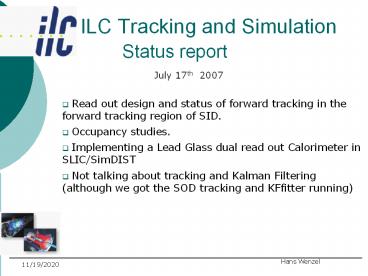ILC Tracking and Simulation Status report - PowerPoint PPT Presentation
Title:
ILC Tracking and Simulation Status report
Description:
Read out design and status of forward tracking in the forward tracking region of ... Summerstudent (until August 10) Francisco Javier Carrion Ruiz. Hans Wenzel ... – PowerPoint PPT presentation
Number of Views:156
Avg rating:3.0/5.0
Title: ILC Tracking and Simulation Status report
1
ILC Tracking and Simulation Status report
July 17th 2007
- Read out design and status of forward tracking
in the forward tracking region of SID. - Occupancy studies.
- Implementing a Lead Glass dual read out
Calorimeter in SLIC/SimDIST - Not talking about tracking and Kalman Filtering
(although we got the SOD tracking and KFfitter
running)
2
Plans to study the Readout designin the forward
region
- Currently one big sensitive silicon disks we
record the Geant 4 SimTrackerHit, no readout
segmentation, one simulated charged track can
leave more than one hit in each layer. - Need to come up with optimum/affordable
tiling/pixeling solutions for the forward
tracking region. - Need to study basic quantities Occupancy,
acceptance etc. (from hits/mm2 to of
Strips/Pixels fired) - Need realistic input for tracking/pattern
recognition studies (Clusters, Digis the whole
class infrastructure) - once thats in place we can do tracking and
pattern recognition studies confusion, ghosting,
resolution... - Tracking up to now heavily depends on various
short cuts
3
Occupancy studiesSummerstudent (until August
10) Francisco Javier Carrion Ruiz
- learn how to access the SimTrackerHits in the
Forward disks using JAS org.lcsim (Java). - improve access toSimTrackerHits (sort and
rearrange). - Compare occupancy distributions of physics
events with beam-beam events. - better understanding of the beam-beam events!
- Try to reproduce some of the plots we found in
literature. - Get started with read out geometry.
4
Data samples.
- Beam-Beam Backgrounds. GUINEA-PIG (Generator of
Unwanted Interactions for Numerical Experiment
AnalysisProgram Interfaced to GEANT) - http//flc.web.lal.in2p3.fr/mdi/BBSIM/bbsim.html
- Sample from ftp server (ILC nominal/SID00)
- ftp//ftp-lcd.slac.stanford.edu/lcd/ILC/ILC500/bac
kgrounds/pairs/ - The individual files were then combined with the
lcio merge command. (checked out from head of
repository) ? very CPU intense to simulate (GRID-
computing) - Used lcsim.org/JAS to study the distribution of
SimTrackerHits in the various forward disks,
calculate hit densities and occupancies. - Looked also into Physics events and simple
readout geometry. No Noise !
5
Wired Event Display of beam beam interactions
photons charged tracks
100,000 e e- g
6
Wired display charged particles only
single hits caused by secondary photon
interactions (mass)
7
PT-cotq distribution of beam-beam background
particles
secondaries
8
Hit distribution and radial Hit density in the
second Vertex End Cap disk
Full simulation 100 beam crossings, Dont think
back scatter is simulated correctly!
0.03 Hits/mm2
9
Whats next
- Fast simulation extrapolate e e- tracks as
simple helices ? obtain particle fluxes through
detector material.
10
Read out iplementation
- When we break the disk up into trapezoids (or
similar)? - We will include a full range of aspect ratios,
long in r, long in phi and approximately square.
(strip lengths and orientations). Stereo. - Do the studies for signal and background events.
- Add noise Hits.
- .......
11
e.g. Norman Grafs Tiling example, 4th concept
double sided Silicon Strip detector with varying
stereo angle. Work with 4th Concept Student
Daniele Barbareschi
Polyhedra replacing cylinders
12
SID Tracker in ILC-ROOT
Hits exist now we are working on the
digitization, plan to port code to lcsim.org
13
Track
Track
Strip/Pad
0
1
N
N1
N2
Sensor reference frame
14
Clustering
Strip/Pad
N
N1
N2
0
1
Sensor reference frame
Cluster List of Strips/pads that make up the
cluster Center of gravity of Cluster provides
uncorrected position measurements in detector
reference frame Nr. of strips, pad/strip size
etc. provide precision of local measurement.
(covariance matrix)?, combination of two clusters
provide stereo information Tracking is driven
from clusters! Only when Cluster is considered to
be part of a track candidate can all the
corrections be applied (alignment, Hall effect,
cluster splitting...) Cluster is defined without
a track trackerhit is not!
15
Lead Glass Dual read out Calorimeter in SLIC
(Simulator for the Linear Collider)
Adam Para et al.
- Lead Glass Calorimeter with dual read out
- Good EM Calorimeter
- hadronic interactions Dual readout to correct
for energy lost in nuclear break ups. Achieve
good energy resolution for hadrons. (similar to
dream) - Longitudinal and transverse segmentation (PFA).
- Decided to put it into SLIC to become familiar
with the framework ? Benefits event display,
event browser, visualization of geometry, xml
geometry description, LCIO output
16
Lead Glass Dual read out Calorimeter in SLIC
- Adding to SLIC required
- Adding optical physics processes.
- Adding optical material properties ? new version
of gdml/fix bug in gdml. - Create LCDD detector description.
- Create new detector (SD) sensitive to Cerenkov
light. - Add LCIO output, Root output.
- LCIO to Root converter.
- All this is now part of SLIC/SIMDIST? we are
contributing
17
Dual read out Calorimeter
Cerenkov (em component) Ld Glass
Alternating layers of lead glass and scintilator
read out segmentation 1 cm2
e- 5GeV
Ionization (scintillator)
Two Components
18
Conclusion!
- Learned what we need to know to now shift gears
and work on the forward tracking.
19
Back up slides
20
Infrastrucure
- Important While doing this studies make sure
that the infrastructure gets build up and that
the corresponding objects - RawTrackerHit, Digis, Cluster are created and
used in the following steps. - For now we don't worry if very simplified
algorithms are used to create this objects. E.g.
dont need sophisticated digitization at the
moment. Dont worry about persistency. - e.g. input to pattern recognition, tracking
should be clusters converted into TrackerHits
(only defined for the track they are used on)!































